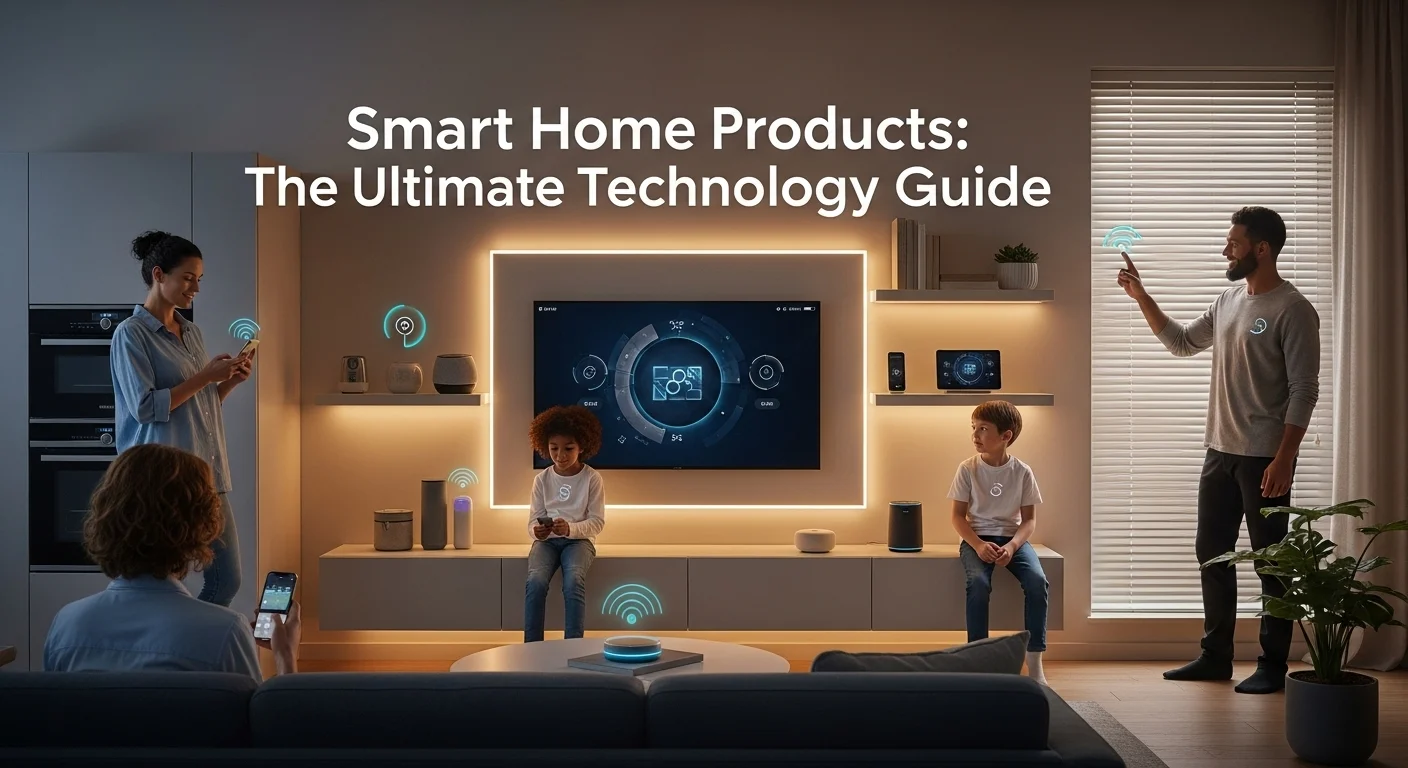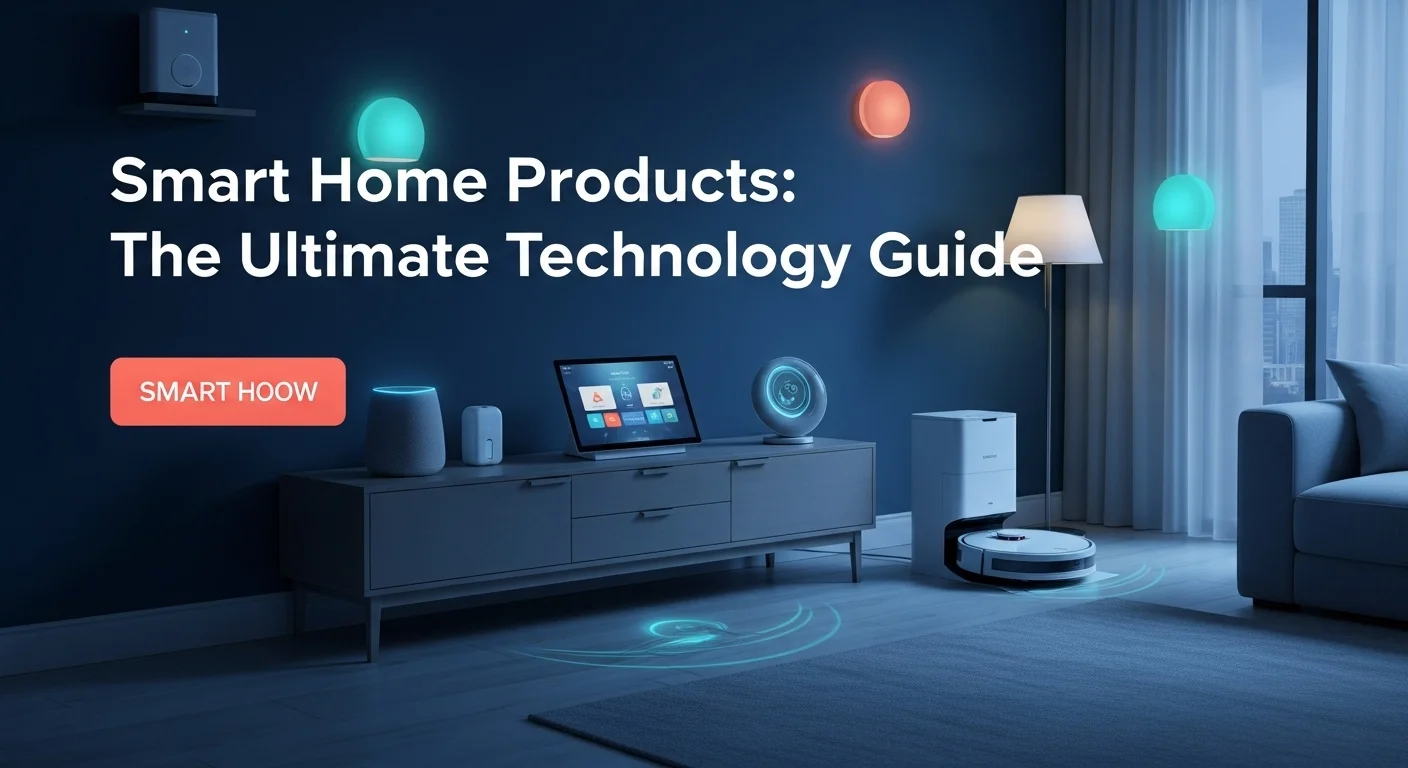Your Ultimate Guide to Smart Home Technology: From Basics to Business

Executive Summary
The concept of a 'smart home' used to feel like something out of a futuristic movie. Today, it's a reality that's reshaping how we live and work. I've spent years watching this technology grow from niche gadgets into a deeply connected ecosystem that's vital for homeowners and businesses alike. This article is my comprehensive guide to help you understand this world. We'll start with the basics, like your first smart light bulb, and move up to the sophisticated systems that control entire homes. We'll pay special attention to smart security, which is often the main reason people jump in. We'll also look at the professional-grade world of Crestron and KNX, the powerhouses behind luxury homes and smart buildings. For business owners, this shift opens doors in real estate, hospitality, and healthcare, boosting efficiency and creating amazing customer experiences. For the rest of us, it’s about making life easier, saving energy, and creating a home that truly responds to our needs. This guide will give you the knowledge you need to navigate this exciting field.
Table of Contents
- What is Smart Home Technology, Really?
- The Core Categories of Smart Devices
- A Look at Professional-Grade Systems: Crestron and KNX
- A Practical Guide to Smart Home Tech and Business Strategy
- How it Works: Protocols and Platforms
- Smart Technology for Your Business
- Diving Deeper into Professional Systems
- Tips to Master Your Smart Home Experience
- Best Practices for Everyone
- Exploring Advanced Tools and Experiences
- Future Trends and Where to Learn More
What is Smart Home Technology, Really?
In my experience, the term 'Home Products' has completely changed its meaning over the last decade. It used to just mean your toaster or your fridge. Now, it describes a web of intelligent, connected devices that make up a 'smart home.' This isn't just a fleeting trend; it’s a fundamental change in how we interact with our living spaces, all thanks to things like the Internet of Things (IoT) and artificial intelligence (AI). Understanding this is key, not just for someone who wants a cool, convenient home, but for the professionals designing and selling these solutions. At its heart, a modern home product is smart because it's connected. It’s not just sitting there; it's communicating with other devices, listening to your commands, and even learning your habits to make life easier without you having to ask. The real magic happens when all these devices start working together as a single ecosystem.
The impact of this technology is huge. It's pushing innovation in so many areas. Our demand for smarter, safer homes fuels new developments in wireless tech, sensors, and cybersecurity. The smart home has become a real-world testing ground for technologies that eventually find their way into other industries. For businesses, this is a multi-billion dollar opportunity that goes way beyond just making and selling gadgets. Integrators, software developers, and security firms are all part of this growing world. Plus, these same ideas are transforming commercial buildings. Hotels use them to create personalized stays with automated lighting and temperature. Real estate developers sell smart-enabled homes as a luxury feature. Assisted living facilities use smart sensors to keep residents safe. It's a cycle: the more devices get connected, the more valuable the network becomes, which leads to even more innovation and more people wanting in. Of course, with all this connectivity comes the critical need for strong cybersecurity.
The Core Categories of Smart Devices
To really get a handle on this, it helps to break it down. The market has something for everyone, from simple DIY gadgets to complex, professionally installed systems.
The entry point for most people is with simple automated devices. This is a huge category that includes anything you can control remotely or that works on a schedule. Think of smart light bulbs from Philips Hue, smart plugs from TP-Link Kasa, or the Google Nest thermostat. I remember my first smart plug; the simple act of turning a lamp on with my voice felt like magic. These devices offer immediate benefits you can see and feel, like saving on your energy bill or making your home more secure by scheduling lights to turn on when you're away. They are the essential building blocks for a smarter home.
Next, you have the brains of the operation: the control platforms and hubs. These are what allow all your different devices to talk to each other. The big names here are Amazon Alexa, Google Home, and Apple HomeKit. They use voice assistants and smartphone apps to give you one central place to control everything. With a single command like 'Goodnight,' you can trigger a whole sequence of events: lights off, doors locked, thermostat down. The power of these platforms is their ability to work with thousands of products from other companies, creating a seamless experience. For the true enthusiasts who want total control, open-source options like Home Assistant are fantastic, though they require a bit more technical know-how.
A huge driver for this market is smart home security. For many people I've worked with, a safer home is their number one reason for investing in this tech. This includes everything from smart cameras like Arlo and Ring, video doorbells, smart locks from August or Schlage, and all kinds of sensors for motion, doors, smoke, or water leaks. These gadgets go far beyond old-school alarm systems. You get instant alerts on your phone, you can see a live video of your front door from anywhere, and you can even talk to a delivery person through your doorbell. When integrated with your other automations, security becomes even more powerful. For instance, a smoke alarm could trigger the lights to turn on, unlock the doors for first responders, and shut off your air system to stop smoke from spreading. Of course, with all this connectivity comes the critical need for strong cybersecurity.
A Look at Professional-Grade Systems: Crestron and KNX
While most of us are familiar with the products from Google and Amazon, the high-end home and commercial markets play in a different league. Here, two names stand out: Crestron and KNX.
Crestron is synonymous with luxury automation. They provide a complete, all-in-one solution, manufacturing both the hardware and the software. Unlike a DIY setup where you're piecing things together, a Crestron system is designed from the ground up to be a perfectly integrated platform that controls everything—lighting, shades, audio, video, climate, security, you name it. From my professional experience, their systems are rock-solid, scalable, and can be customized to an incredible degree. You don't buy this off the shelf; it's installed and programmed by certified professionals who tailor it to your exact needs. This is how you get those flawless home theaters where one button press dims the lights, lowers the screen, and starts the movie. You'll find Crestron in luxury estates, corporate boardrooms, and high-end hotels where absolute reliability is non-negotiable.
KNX, on the other hand, is built on the philosophy of an open standard. It's not one company but a global standard for building control supported by hundreds of manufacturers. This is a huge deal because it means you can use KNX-certified devices from different companies like Siemens or ABB, and they'll all work together perfectly. The system is built around a robust, decentralized network line. This makes it incredibly reliable—if one device fails, the rest of the system keeps running. KNX is famous for its flexibility and energy efficiency. By automating things based on whether someone is in a room or based on a schedule, it can seriously cut down a building's energy use. Like Crestron, KNX systems are installed by certified pros. The open standard makes it a future-proof choice, since you’re not locked into one company's products. It's especially popular in Europe for both homes and large commercial projects.

A Practical Guide to Smart Home Tech and Business Strategy
Diving into the world of smart home technology requires more than just buying a few gadgets. To do it right, you need to understand the tech that makes it all work, see the opportunities for your business, and know where to turn for solid advice. This guide will walk you through the core technologies, show you how businesses can use them to get ahead, and highlight the resources you need. From the wireless protocols that let devices talk, to the ecosystems that unite them, and the absolute necessity of cybersecurity, having this knowledge is key to making smart choices, whether you’re a homeowner, a developer, or a business leader.
How it Works: Protocols and Platforms
The secret sauce of a smart home is communication—the ability for all your devices to talk to each other. This is managed by rules called protocols. Here are the main ones you'll encounter:
1. Wi-Fi: Everyone has it, everyone understands it. Wi-Fi is great for devices that need to send a lot of data, like a security camera streaming video. The downside? It can be a power hog for battery-operated devices, and too many smart gadgets can slow down your home network, just like a traffic jam on a highway.
2. Bluetooth & Bluetooth Low Energy (BLE): Perfect for short-range tasks, like your phone unlocking your front door as you approach. The BLE version is incredibly power-efficient, making it ideal for small, battery-powered sensors that just need to send tiny bits of information now and then.
3. Zigbee & Z-Wave: These were built from the ground up for home automation. They are low-power and create a 'mesh network.' In a mesh network, devices can pass signals along to each other, which extends the network's range and makes it more reliable. This is a huge plus in larger homes. They also operate on different frequencies from Wi-Fi, which means less interference. Both typically need a central hub to connect to the internet.
4. Thread & Matter: This is the future, and frankly, it's what I'm most excited about. Thread is another low-power mesh network, but it's built to be more direct and doesn't need a proprietary hub. The real game-changer is Matter. Developed by all the big players (Apple, Google, Amazon, etc.), Matter is a universal language for smart devices. A 'Matter-certified' logo means it will work with any Matter-compatible system. This promises to finally solve the biggest headache for consumers: figuring out what works with what.
Beyond the protocol, you need to choose your control platform, or ecosystem. The main choices are Amazon Alexa, Google Home, and Apple HomeKit. These platforms provide the voice assistants and apps that bring all your devices together under one roof. For anyone developing a smart product, being compatible with these ecosystems is essential. For you as a user, your choice might just come down to whether you prefer an iPhone or an Android.
Smart Technology for Your Business
Using this tech in a business setting is a booming field. Companies can use it to streamline operations, delight customers, and even open up new ways to make money. For instance, a small bed and breakfast can use smart locks for easy, key-free check-ins, use smart thermostats to save money when rooms are empty, and use smart lighting to create a warm welcome. In an office, the same gadgets can be used to control lights and temperature based on when people are actually there, slashing utility bills. Smart scheduling systems can even sync with meeting room displays to end booking confusion for good.
A critical step for any business is to calculate the Return on Investment (ROI). The initial cost can feel high, but the long-term savings are often worth it. Here’s how you measure it:
- Energy Savings: This is the most obvious one. Smart climate and lighting controls lead to smaller utility bills.
- Operational Efficiency: When you automate tasks like managing room access or adjusting the lights, your staff has more time for important work.
- Better Security: Modern surveillance and access control can reduce theft and might even get you a discount on your insurance.
- Higher Revenue: In hospitality or real estate, smart features are a premium offering that can justify higher rates or property values.
However, the biggest risk in all of this is cybersecurity. Every connected device is a potential way in for hackers. I can't stress this enough. Businesses must take security seriously:
- Segment Your Network: Keep your smart devices on a separate Wi-Fi network from your computers with sensitive business data.
- Use Strong Passwords: Change every default password. Make them long, unique, and complex. Use two-factor authentication whenever you can.
- Update Everything: Always keep your device firmware and software up to date. These updates often contain critical security patches.
- Get a Professional Audit: For larger setups, it's worth hiring a cybersecurity expert to check your system for weaknesses.
Diving Deeper into Professional Systems
For businesses or homeowners who need top-tier reliability and customization, consumer gadgets might not cut it. This is where professional systems like Crestron and KNX shine.
I've seen firsthand how Crestron's all-in-one approach is a huge benefit for critical business functions. Because they make everything—the hardware, the software, the touchscreens—the entire system is engineered for flawless integration. This eliminates many of the headaches that come from mixing and matching brands. In a corporate boardroom, a Crestron system can reliably manage a complex video conference setup with one touch. For a luxury hotel, it delivers a consistent, premium experience in every room while giving management a central dashboard to control energy use. The upfront investment is higher, but for businesses, the unparalleled reliability and support deliver a powerful ROI.
The KNX ecosystem offers a different, but equally powerful, advantage: flexibility through its open standard. With hundreds of manufacturers making thousands of compatible products, you are never locked into one vendor. You can pick the absolute best device for any given job, knowing it will work with the rest of your system. This competition also drives innovation and can be more cost-effective. The decentralized design of a KNX system is a major plus for commercial buildings; if one sensor fails, the rest of the building's lighting and climate control keep working. It's a fantastic choice for large-scale projects where scalability and long-term maintenance are top priorities.

Tips to Master Your Smart Home Experience
Let's get practical. Turning your home or business into a smart environment is about more than just buying cool tech. It's about smart planning, a relentless focus on security, and having a strategy for the future. Whether you're a hobbyist creating the ultimate connected home or a business owner looking to automate, following these best practices will make a world of difference and ensure you get the most from your investment. Here are my top tips and strategies for creating a secure, efficient, and enjoyable smart ecosystem.
Best Practices for Everyone
Your journey into smart technology should always start with a clear plan. For home users, think about your daily frustrations. What tasks could be automated to make your life easier? My advice is to start small. Don't try to automate your entire house in one weekend. Pick one area, like lighting, and one major ecosystem (Amazon, Google, or Apple) to build around. This will make it much easier to add new devices later without running into compatibility issues.
For businesses, the planning needs to be even more rigorous, with a focus on scalability and ROI. What are you trying to achieve? Lower energy bills? Tighter security? A better customer experience? Choose systems that can grow with you. While a few DIY gadgets might work for a small office, a professionally installed system from a provider like KNX or Crestron will offer the reliability and scalability a larger company needs. Make sure your budget covers not just the hardware, but also installation, maintenance, and future upgrades.
Cybersecurity is not optional; it is essential for everyone. The number of connected devices, especially security cameras and locks, creates many potential vulnerabilities.
- Lock Down Your Router: Your Wi-Fi router is the front door to your digital home. Change the default admin password, use the strongest WPA3 encryption, and always keep its software updated.
- Create a Guest Network: Put all your smart devices on a separate guest Wi-Fi network. This simple step, called network segmentation, means that even if a hacker compromises your smart toaster, they can't get to your personal computer or company files.
- Practice Good Password Hygiene: Never, ever use the default password on a device. Every single device and service needs a unique, strong password. A password manager is your best friend here.
- Turn on Two-Factor Authentication (2FA): Always enable 2FA for the main accounts that control your smart home (like your Google or Apple account). It’s one of the most effective security measures you can take.
- Check App Permissions: When you install a new app for a device, be skeptical. Does your smart bulb app really need access to your contacts? If it seems unnecessary, deny the permission.
Exploring Advanced Tools and Experiences
Once you have the basics down, you can start having some real fun. Instead of just using the manufacturer's app, power users can explore platforms like Home Assistant or IFTTT (If This Then That). Home Assistant is my personal favorite for serious hobbyists; it's an open-source platform that gives you total local control and privacy. It lets you connect devices from hundreds of brands and create incredibly powerful automations that no single company's ecosystem can match. IFTTT is simpler and connects different apps and services with 'if this, then that' rules, like having your security camera's motion alerts automatically logged in a spreadsheet.
When you dive into specific product lines, you see how deep the experience can go. The Philips Hue lighting system, for instance, is about so much more than turning lights on and off. You can sync your lights to movies and music, create scenes that shift throughout the day, or have them turn on automatically when you walk into a room. When integrated into a larger system, these lights can become a security feature, flashing red during an alarm, or a wellness tool, slowly brightening in the morning to gently wake you up.
For a truly premium experience, you have to look at what Crestron offers. I've been in homes and boardrooms with their systems, and the level of seamless integration is incredible. A single, beautiful touchscreen on a wall can control a sophisticated AV system, motorized shades, climate in every room, and a complex security network. The experience is so intuitive because every single piece was designed to work together as one. Similarly, a building powered by KNX shows the strength of an open, reliable standard. In a smart hotel using KNX, the lights, heating, and blinds in a room can automatically switch to an energy-saving mode the moment a guest checks out, delivering real, measurable savings to the business.
Future Trends and Where to Learn More
This field never stops moving. Looking ahead, I see Artificial Intelligence (AI) making our homes more proactive. Instead of just following commands, they'll start to anticipate our needs by learning our habits. Imagine a home that knows you had a stressful day based on your calendar and smartwatch data, and automatically dims the lights and plays relaxing music when you get home. This idea of 'ambient computing,' where the tech fades into the background, is the next frontier. Sustainability will also become even more important, with homes integrating with smart grids to optimize energy use and manage power from solar panels and batteries.
To keep up with this rapid change, you need reliable sources. Tech publications like The Verge and WIRED are great for news on consumer gadgets. For a deeper dive into the standards, the official website of the Connectivity Standards Alliance (the group behind Matter) is essential. And if you want to get serious about security, I highly recommend Kaspersky's guide, Securing Your Smart Home, which has practical advice for everyone. By combining a smart strategy, a security-first mindset, and a desire to keep learning, you can unlock the true potential of smart technology and create a responsive, secure, and truly intelligent environment.
Expert Reviews & Testimonials
Sarah Johnson, Business Owner ⭐⭐⭐
This is a solid overview, but as a business owner, I would have loved to see a few more real-world case studies with hard numbers.
Mike Chen, IT Consultant ⭐⭐⭐⭐
A great read that clarified a lot for me about the different protocols. The explanation of Matter was particularly helpful. Very useful article!
Emma Davis, Tech Expert ⭐⭐⭐⭐⭐
Fantastic and comprehensive article! It covers the topic from the DIY level all the way to professional systems like Crestron and KNX. I've already recommended it to colleagues.



